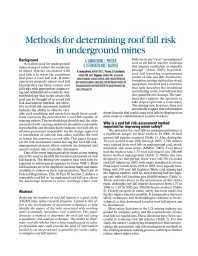Mining Publication: Methods for Determining Roof Fall Risk in Underground Mines
Original creation date: November 2007
Reducing the number of roof fall injuries is a goal of the NIOSH mine safety research program. Central to this effort is the development of assessment techniques that will help to identify the nature of the risks associated with working under potentially hazardous roof conditions. This paper discusses a method to determine the roof fall risk using a qualitative risk analysis technique. The ability to determine roof fall risk has been a long-standing goal of safety professionals and can provide the kind of information, needed by on-site personnel responsible for worker safety, to mitigate roof fall injuries.
Authors: AT Iannacchione, LJ Prosser, GS Esterhuizen, TS Bajpayee
Peer Reviewed Journal Article - November 2007
NIOSHTIC2 Number: 20032865
Min Eng 2007 Nov; 59(11):47-53
See Also
- Characteristics of Mining-Induced Seismicity Associated with Roof Falls and Roof Caving Events
- Horizontal Stress
- Mapping Hazards with Microseismic Technology to Anticipate Roof Falls - A Case Study
- Performance Characteristics for Welded Wire Screen Used for Surface Control in Underground Coal Mines
- Practical Risk Assessment Guidelines for Identifying, Assessing, and Mitigating Stored Energy Hazards in Underground Coal Mines During and After a Mine Emergency
- SPONCOM - A Computer Program for the Prediction of the Spontaneous Combustion Potential of an Underground Coal Mine
- Stability Mapping to Examine Ground Failure Risk: A Field Study at a Limestone Mine
- Technical Solutions for Enhancements to Mine Safety Using Barricade II Fire Blocking Gel
- Technology News 545 - NIOSH Updates Spontaneous Combustion Assessment Software
- Through-The-Earth Wireless Real-Time Two-Way Voice Communications
- Content source: National Institute for Occupational Safety and Health, Mining Program


 ShareCompartir
ShareCompartir
